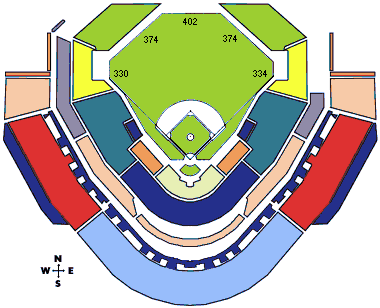PNC Park - Home of the Pittsburgh Pirates

Construction on the Pirates new home was finished in 2001. Despite the short porches down the lines (325' to left, 320' to right), and the relatively short distance to the center field wall (399'), there are not many home runs hit at PNC compared to other parks. In fact, in 2006, home runs at PNC occurred only about 82% as often as they did at other parks. Blame the weak-hitting Pirates if you like, but consider that there were 26% more doubles hit there in '06 than at other ballyards. That means that if a player (say Adam Laroche) gets traded to Pittsburgh, you can expect a slight Home Run production dropoff.
By the way, the Pirates have managed only six dingers at home so far this year (last in MLB), compared to 12 on the road.
Chase Field - Home of the Arizona Diamondbacks
(also known as Bank One Ballpark, or the BOB)

The BOB was the most prolific park for hitters in 2006, near the top in several offensive categories. When you realize that the other teams in the NL West are not exactly offensive juggernauts, this ballpark is having a tremendous effect on runs scored throughout the year. Home Runs and triples occur quite a bit more here than they do in other stadiums, producing more runs. The BOB also sees more hits, walks and doubles than other parks do. Thus, if your fantasy pitcher is getting a couple of starts in Arizona soon, you might want to give him a seat on the bench.
Fenway Park - Home of the Boston Red Sox

Home of the Green Monster, Fenway has been the host to some of the game's most memorable home runs. Although the Red Sox pitching underperformed in 2006, there were not a huge amount of homers hit at Fenway. The monster takes away a good number of shots to left field, and the cavernous center field turns many homers into doubles or outs. While Fenway ranked 13th in runs in '06, it ranked 29th in Home Runs, and 1st by a wide margin in doubles. Guys like Mike Lowell and Kevin Youkilis will flourish in Boston, but don't expect them to hit too many out of the park.
Petco Park - Home of the San Diego Padres

Always known as a pitcher's park, Petco has kept Home Run hitters from donning the Padre uniform simply because they knew their home run totals would suffer. Or would they?
In 2006, San Diego's home field ranked a very average 16th in home runs, above average in triples, and about average in walks. The Padre ballpark yielded fewer doubles than any other park, and likewise, fewer runs than any other park.
The NL West is the most interesting division when it comes to ballpark effect. Besides Arizona and San Diego, which were mentioned above, the division also features AT & T park in San Francisco, which was dead last in home runs, but 16th in total runs. Also in the division is the notorious Coors Field, which has become strangely normal the last few years, although it was 2nd in runs and 10th in home runs in 2006. The LA Dodgers have recently been known for their good pitching, but Dodger Stadium was 10th in runs and 7th in home runs last year.
No comments:
Post a Comment